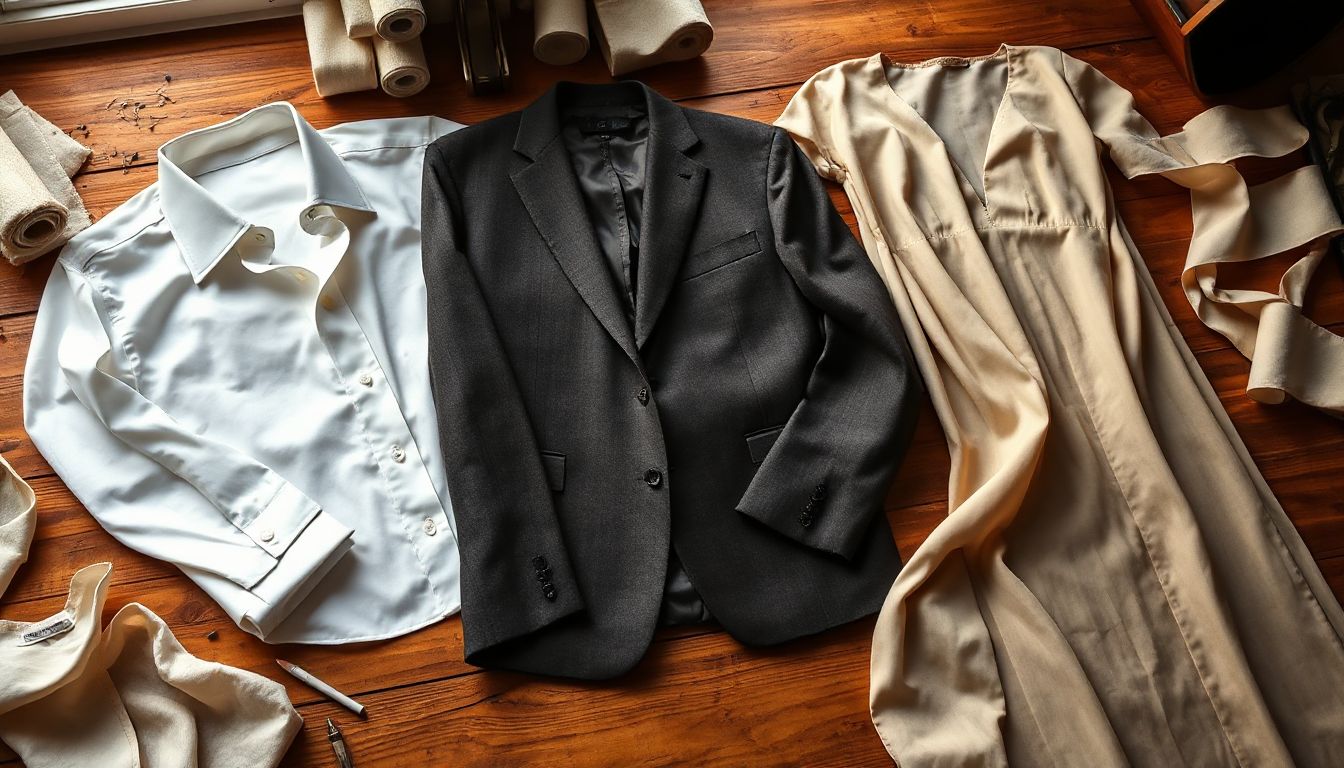How to Choose the Right Interlining for Shirts, Suits, and Dresses

Imagine slipping into a perfectly tailored suit that drapes just right over your shoulders. It feels great at first. But after a few wears, it starts to stiffen and lose shape. The wrong interlining can ruin even the best garment. At Sadiq Interlining, we know interlining acts as the hidden backbone in shirts, suits, and dresses. It gives structure, holds the shape, and boosts comfort. Without it, clothes sag or wrinkle too fast. This guide covers interlining types, key choices, and expert tips for each garment. You’ll learn how to pick the best one for lasting wear, whether for work or daily outfits.
Understanding Interlining Basics
Interlining supports the main fabric in clothes. It sits between the outer layer and lining. This extra layer keeps everything in place.
What Is Interlining and Why Does It Matter?
Interlining is a fabric layer fused or sewn inside garments. It provides shape and stops wrinkles. It also improves how the whole piece fits your body. Think of it as the skeleton for your clothes. Without good interlining, a shirt might pucker at the collar. A suit could lose its sharp lines over time. For dresses, it helps maintain flow without sagging. To pick wisely, look at your garment’s fabric weight. Light fabrics need thin interlining. Heavy ones call for stronger support. This match ensures durability and comfort.
Already curious? Check our detailed blog: Woven Fusible Interlinings in Pakistan
Common Types of Interlining Materials
Many materials work for interlining. Cotton feels soft and breathes well. Wool adds warmth but can be stiff. Synthetic fusibles, like polyester, bond with heat for easy use. Canvas gives firm structure, often in suits. Each has upsides and downsides. Cotton excels in breathability but may shrink. Synthetics hold up to washing better yet trap heat. Wool offers natural rigidity but costs more. To choose, feel samples by hand. Pinch and stretch them. This helps match the feel to your project needs. For shirts, go light with cotton. Suits benefit from canvas blends.
Interlining Attachment Methods
You can fuse interlining with heat or sew it in place. Fusing uses adhesive that activates under an iron. It’s quick for flat areas like collars. Sewing works for curves or heavy fabrics. Hand-stitch for fine control, or machine for speed. For shirts, light fusing keeps things simple and crisp. Suits often need sewn canvas for lasting shape. Dresses suit flexible sewn options to allow movement. Pick based on your fabric. Delicate silk might tear with heat, so sew instead. Always ask a tailor if unsure. They check if the method fits your cloth without damage.
Key Factors to Consider When Selecting Interlining
Picking interlining involves a few steps. Start with your garment’s style and use. Then match the details to fit right.
Fabric Weight and Compatibility
Match interlining weight to the outer fabric. Light cotton shirts pair with thin interlining. Wool suits take medium or heavy layers. This prevents bulk or weakness. Use a simple scale to weigh samples. Or compare by eye with a guide chart. For a cotton dress, pick lightweight fusible. It blends without adding heft. Heavy denim shirts need sturdier options to hold seams. Get this right, and your garment hangs smooth.
Breathability and Comfort Levels
Breathable interlining keeps you cool. Cotton or organdy lets air flow for summer wear. Synthetics suit structured pieces but can feel warm. For skin that reacts easy, choose natural fibers. In hot spots, this cuts sweat buildup. Test by wearing a sample scrap. Feel how it wicks moisture. Dresses in silk shine with airy layers. Suits in business settings might need blends for all-day ease.
Durability and Maintenance Needs
Look for interlining that lasts through washes and wears. Fusibles often handle machine cycles without peeling. Woven types resist creases better in suits. Check labels for care rules. Pick washable ones for daily shirts to save time. Avoid dry-clean only if you hate the hassle. Strong interlining means fewer repairs. It keeps shape even after years.
💡 Pro Tip from Sadiq Interlining: Always “pinch and feel” the sample. If it feels bulky compared to your fabric, it’ll ruin the garment’s balance.
Explore more: Non-Woven Fusible Interlinings
Choosing Interlining for Shirts
Shirts need light support. They move with you all day. Focus on collars and cuffs for crisp looks.
Best Interlinings for Casual Button-Down Shirts
Soft cotton works great for button-downs. It allows natural bend without stiffness. Fuse it lightly at edges for shape. This keeps collars standing tall. Avoid thick layers that bunch up. For cotton oxford shirts, try non-fusible batiste. It drapes easy and breathes. Test on a scrap first. Fuse the collar points. Then sew the body for flex.
Interlining Options for Formal Dress Shirts
Woven fusibles fit dress shirts best. They sharpen plackets and collars. Use thin ones to dodge bulk. This holds up during long events. Polyester blends add durability. They resist yellowing from sweat. Layer just once for smooth feel. Pick white to match most fabrics.
- Fuse collars for crisp edges.
- Skip body interlining to stay comfy.
- Check for non-woven options in summer.
Common Mistakes to Avoid
Heavy interlining causes puckers on shirts. It pulls seams wrong. Always prototype on leftover cloth. Wear it a bit to test. Don’t skip this step. It saves big fixes later. Another slip: ignoring fabric type. Silk shirts need gentle layers. Or they tear easy.
Read more: Interlinings Manufacturer in Pakistan – Why Sadiq Interlinings Leads the Garment Industry
Selecting Interlining for Suits
Suits demand strong structure. The silhouette matters most. Classic methods build trust in the fit.
Interlining for Jacket and Lapel Structure
Horsehair canvas shapes jackets right. It rolls soft at lapels in wool suits. Layer it for custom shoulders. This gives that sharp line tailors love. Fuse edges, sew the core. Blends with cotton soften the feel. Use medium weight for business suits. It holds through seasons.
Options for Suit Pants and Vests
Fusible polyester strengthens pants waistbands. It stops sagging over time. For vests, breathable weaves add comfort. Pick blends that match wool. Fuse the bands quick. Sew vests for flex in formal wear. This setup lasts dry cleans.
- Poly for pants: Easy and strong.
- Cotton-wool for vests: Warm yet light.
- Test steam on samples.
Balancing Formality and Flexibility
Semi-fusible hybrids fit modern suits. They mix structure with give. Steam after to set the shape. This adapts to your moves. For formal black ties, stick to full canvas. Everyday gray suits take lighter loads. Balance keeps it versatile.
Picking Interlining for Dresses
Dresses blend form and flow. Bodices need support, skirts want ease. Style guides the pick.
Interlining for Structured Bodices and Corsetry
Power mesh supports fitted bodices. It shapes without boning. Coutil works for corset styles. Fuse hems light to keep flow. This adds lift in sheaths. Avoid heavy adds that weigh down. For evening gowns, layer thin for grace.
Choices for Flowing Skirts and Sleeves
Sheer organza boosts skirt volume. It adds poof without weight. For sleeves, light tulle gives puff. Skip fusing to save drape in chiffon. This lets silk move free. Pick colors close to outer for hide.
- Organza for skirts: Airy lift.
- Tulle for sleeves: Soft shape.
- Test drape on a mannequin.
Adapting for Seasonal and Style Variations
Light synthetics cool summer dresses. Wool blends warm winter ones. Check in natural light for match. Sheaths take firm options. Ballgowns need volume layers. Adjust for your climate. Samples help spot sheen fits.
Conclusion
Choosing interlining comes down to matching material, weight, and method to the garment. Light picks suit shirts for daily ease. Structured ones build suits that last. Fluid layers keep dresses flowing right. Test every choice on scraps. Put comfort first in your picks. Talk to pros for tough jobs. This way, you get pro results at home. Grab samples from good suppliers now. Try them out to boost your sewing skills. Make clothes that fit perfect and endure.
💡 Pro Tip from Pakistan’s Leading Interlining Manufacturer: Always request samples before bulk purchasing. A five-minute fabric test saves you from costly production errors.
If you’re looking for high-quality woven and non-woven fusible interlinings in Pakistan, Sadiq Interlining is your trusted partner. From shirts to premium suits, we deliver interlinings that make garments last longer and look sharper.
